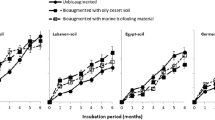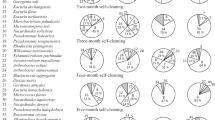Abstract
A field study was initiated in December 2000 in two selected sub-Antarctic soils (Kerguelen Archipelago) with the objective of determining the long-term effects of a fertilizer addition on the degradation rate and the toxicity of oil residues under severe sub-Antarctic conditions. Two soils were selected. The first site was an organic soil supporting an abundant vegetal cover while the second one was a mineral soil, free from vegetation. Both soils were located in the vicinity of the permanent station of Port-aux-Français (69°42′E−49°19′S). Two series of five experimental plots (0.75 × 0.7 5 m) were settled firmly into each of the studied soils. Each plot received 500 ml of diesel fuel or Arabian light crude oil and some of them were treated with a bioremediation agent: the slow release fertilizer Inipol EAP-22® (Elf Atochem). All plots were sampled on a regular basis over a 4-year period. The microbial response was improved by bioremediation treatments but fertilizer addition had a greater impact on the mineral soil when compared to the organic one. The rate of degradation was significantly improved by bioremediation treatments. However, even after 4 years, the toxicity of oiled soils as determined by Microtox solid phase tests showed a persistent response in spite of an apparent significant degradation of alkanes and aromatics. Despite the very small amount of contaminant used in this experiment, 4 years of bioremediation was not sufficient to obtain a complete return to pristine conditions





Similar content being viewed by others
References
Aislabie J, McLeod M, Fraser R (1998) Potential for biodegradation of hydrocarbons in soil from the Ross dependency, Antarctica. Appl Microbiol Biotechnol 49:210–214
Aislabie J, Fraser R, Duncan S, Farrell RL (2001) Effects of oil spills on microbial heterotrophs in Antarctic soils. Potential for biodegradation of hydrocarbons in soil from the Ross dependency, Antarctica. Polar Biol 24:308–313
Aislabie J, Balks JM, Foght JM, Waterhouse EJ (2004) Hydrocarbon spills on Antarctic soil: effect and management. Environ Sci Technol 38:1265–1274
Atlas RM (1981) Microbial degradation of petroleum hydrocarbons: an environmental perspective. Microbiol Rev 45:180–209
Baraniecki CA, Aislabie J, Foght JM (2002) Characterization of Sphingomonas sp. Ant 17, an aromatic hydrocarbon-degrading bacterium isolated from Antarctic soil. Microbiol Ecol 43:44–54
Benton MJ, Malott ML, Knight SS, Cooper CM, Benson WH (1995) Influence of sediment composition on apparent toxicity in a solid phase test using bioluminescent bacteria. Environ Toxicol Chem 14:411–414
Bossert ID, Bartha R (1986) Structure biodegradability relationships of polycyclic aromatic hydrocarbons in soil. Bull Environ Contamin Toxicol 37:490–495
Bragg JR, Prince RC, Harner EJ, Atlas RM (1994) Effectiveness of bioremediation for the Exxon Valdez oil spill. Nature 368:413–418
Butler EL, Douglas GS, Steinhauer WG, Prince RC, Aczel T, Hsu CS (1991) Hopane, a new chemical tool for measuring oil biodegradation. In: Inchee RE, Olfenbuttel RF (eds) On site bioreclamation, processes for xenobiotic and hydrocarbon treatment. Butterworth-Heinemann, Oxford, pp 515–521
Cripps GC, Shears J (1997) The fate in the marine environment of a minor diesel fuel spill from an Antarctic research station. Environ Monit Asses 46:221–232
Coulon F, Delille D (2006) Influence of substratum on the biodegradation processes in diesel polluted sub-Antarctic soils (Crozet Archipelago). Polar Biol 29:806–812
Coulon F, Pelletier E, St Louis R, Gourhant L, Delille D (2004) Degradation of petroleum hydrocarbons in two sub-Antarctic soils: influence of an oleophilic fertilizer. Environ Toxicol Chem 23:1893–1901
Countway RE, Dickhut RM, Canuel EA (2003) Polycyclic aromatic hydrocarbon (PAH) distributions and associations with organic matter in surface waters of the York River, VA. Estuary Org Geochem 34:209–224
Delille D (2000) Response of Antarctic soil bacterial assemblages to contamination by diesel fuel and crude oil. Microbiol Ecol 40:159–168
Delille D, Pelletier E (2002) Natural attenuation of diesel-oil contamination in a subantarctic soil (Crozet Island). Polar Biol 25:682–687
Delille D, Siron R (1993) Effect of dispersed oil on heterotrophic bacterial communities in cold marine waters. Microbiol Ecol 25:263–273
Delille D, Delille B, Pelletier E (2002) Effectiveness of bioremediation of crude oil contaminated subAntarctic intertidal sediment: the microbial response. Microbiol Ecol 44:118–126
Delille D, Coulon F, Pelletier E (2004) Biostimulation of natural microbial assemblages in oil-amended vegetated and desert sub-Antarctic soils. Microbiol Ecol 47:407–415
Ferguson SH, Franzmann PD, Revill AT, Snape AI, Rayner JL (2003) The effects of nitrogen and water on mineralisation of hydrocarbons in diesel-contaminated terrestrial Antarctic soils. Cold Reg Sci Technol 37:197–212
Hobbie JE, Daley RJ, Jasper S (1977) Use of nuclepore filters for counting bacteria by fluorescence microscopy. Appl Environ Microbiol 33:1225–1228
Joergensen RG, Schmadeke F, Windhorst K, Meyer B (1995) Biomass and activity of microorganisms in a fuel oil contaminated soil. Soil Biol Biochem 27:1137–1143
Kerry E (1993) Bioremediation of experimental petroleum spills on mineral soils in the Vesfold Hills, Antarctica. Polar Biol 13:163–170
Kubatova A, Dronen LD, Picklo MJ, Hawthorne SB (2006) Midpolarity and nonpolar wood smoke particulate matter fractions deplete glutathione in RAW 264.7 macrophages. Chem Res Toxicol 19:255–261
Long SC, Aelion CM, Dobbins DC, Pfaender FK (1995) A comparison of microbial community characteristics among petroleum-contaminated and uncontaminated subsurface soils samples. Microbiol Ecol 30:297–307
Margesin R, Schinner F (1997) Laboratory bioremediation experiments with soil from a diesel-oil contaminated site: Significant role of cold-adapted microorganisms and fertilizers. J Chem Technol Biotechnol 70:92–98
Microbics Corporation (1992) Detailed solid-phase test protocol, in Microtox manual, a toxicity testing. Handbook, edition
Mills AL, Breuil C, Colwell RR (1978) Enumeration of petroleum-degrading marine and estuarine microorganisms by the most probable number method. Can J Microbiol 24:552–557
Møller J, Winther P, Lund B, Kirkebjerg K, Westermann P (1996) Bioventing of diesel oil-contaminated soil: comparison of degradation rates in soil based on actual oil concentration and resprometric data. J Indus Microbiol 16:110–116
Oppenheimer CH, ZoBell CE (1952) The growth and viability of sixty three species of marine bacteria as influenced by hydrostatic pressure. J Mar Res 11:10–18
Pelletier E, Delille D, Delille B (2004) Crude oil bioremediation in sub-Antarctic intertidal sediments: chemistry and toxicity of oiled residues. Mar Environ Res 57:311–327
Prince RC, Garrett RM, Bare RE, Grossman MJ, Townsend T, Suflita JM, Lee K, Owens EH, Sergy GA, Braddock JF, Lindstrom JE, Lessard RR (2003) The roles of photooxidation and biodegradation in long-term weathering of crude and heavy fuel oils. Spill Sci Technol Bull 8:145–156
Sims JL, Sims RC, Matthews JE (1990) Approach to bioremediation of contaminated soil. Hazardous Waste and Hazardous Materials 7:117–149
Snape I, Riddle MJ, Stark JS, Cole CM, King CK, Duquesne S, Gore DB (2001) Management and remediation of contaminated sites at Casey Station, Antarctica. Polar Record 37:199–214
Stallwood B, Shears J, Williams PA, Hugues KA (2005) Low temperature bioremediation of oil-contaminated soil using biostimulation and bioaugmentation with a Pseudomonas sp. from maritime Antarctica. J Appl Microbiol 99:794–802
Walworth JL, Reynolds CM (1995) Bioremediation of a petroleum-contaminated cryic soil: effects of phosphorous, nitrogen, and temperature. J Soil Contam 4:299–310
Acknowledgments
This research was supported by the French Polar Institute “IPEV”, the Research Chair of Canada in marine ecotoxicology (EP), the Natural Sciences and Engineering Research Council of Canada and the European Project COMMODE (EVK3–CT2002–00077).
Author information
Authors and Affiliations
Corresponding author
Rights and permissions
About this article
Cite this article
Delille, D., Coulon, F. & Pelletier, E. Long-term changes of bacterial abundance, hydrocarbon concentration and toxicity during a biostimulation treatment of oil-amended organic and mineral sub-Antarctic soils. Polar Biol 30, 925–933 (2007). https://doi.org/10.1007/s00300-007-0252-8
Received:
Revised:
Accepted:
Published:
Issue Date:
DOI: https://doi.org/10.1007/s00300-007-0252-8




